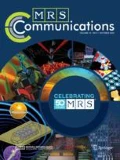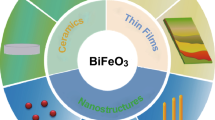Abstract
The fabrication of bimetallic magnetic nanoparticles (NPs) smaller than the size of single magnetic domain is very challenging because of the agglomeration, non-uniform size, and possible complex chemistry at nanoscale. In this paper, we present an alloyed ferromagnetic 4 ± 1 nm thiolated Au/Co magnetic NPs with decahedral and icosahedral shape. The NPs were characterized by Cs-corrected scanning transmission electron microscopy (STEM) and weretheoretically studied by Grand Canonical Monte Carlo simulations. Comparison of Z-contrast imaging and energy dispersive x-ray spectroscopy used jointly with STEM simulated images from theoretical models uniquely showed an inhomogeneous alloying with minor segregation. The magnetic measurements obtained from superconducting quantum interference device magnetometer exhibited ferromagnetic behavior. This magnetic nanoalloy in the range of single domain is fully magnetized and carries significance as a promising candidate for magnetic data recording, permanent magnetization, and biomedical applications.





Similar content being viewed by others
References
A.-H. Lu, W. Schmidt, N. Matoussevitch, H. Bönnemann, B. Spliethoff, B. Tesche, E. Bill, W. Kiefer, and F. Schüth: Nanoengineering of a magnetically separable hydrogenation catalyst. Angew. Chem., Int. Ed. 43, 4303 (2004).
G. Reiss and A. Hutten: Magnetic nanoparticles: applications beyond data storage. Nat. Mater. 4, 725 (2005).
B. Gleich and J. Weizenecker: Tomographic imaging using the nonlinear response of magnetic particles. Nature 435, 1214 (2005).
R.N. Grass, E.K. Athanassiou, and W.J. Stark: Covalently functionalized cobalt nanoparticles as a platform for magnetic separations in organic synthesis. Angew. Chem., Int. Ed. 46, 4909 (2007).
D.W. Elliott and W.X. Zhang: Field assessment of nanoscale bimetallic particles for groundwater treatment. Environ. Sci. Technol. 35, 4922 (2001).
J. Dobson: Magnetic nanoparticles for drug delivery. Drug Dev. Res. 67, 55 (2006).
Y. Kobayashi, M. Horie, M. Konno, B. Rodríguez-González, and L.M. Liz-Marzán: Preparation and properties of silica-coated cobalt nanoparticles†. J. Phys. Chem. B 107, 7420 (2003).
J. Gao, H. Gu, and B. Xu: Multifunctional magnetic nanoparticles: design, synthesis, and biomedical applications. Acc. Chem. Res. 42, 1097 (2009).
Y. Bao and K.M. Krishnan: Preparation of functionalized and gold-coated cobalt nanocrystals for biomedical applications. J. Magn. Magn. Mater. 293, 15 (2005).
Q.A. Pankhurst, J. Connolly, S.K. Jones, and J. Dobson: Applications of magnetic nanoparticles in biomedicine. J. Phys. D: Appl. Phys. 36, R167 (2003).
Z. Lu, M.D. Prouty, Z. Guo, V.O. Golub, C.S.S.R. Kumar, and Y.M. Lvov: Magnetic switch of permeability for polyelectrolyte microcapsules embedded with Co@Au nanoparticles. Langmuir 21, 2042 (2005).
A.H. Lu, E.e.L. Salabas, and F. Schüth: Magnetic nanoparticles: synthesis, protection, functionalization, and application. Angew. Chem., Int. Ed. 46, 1222 (2007).
T. Iwaki, Y. Kakihara, T. Toda, M. Abdullah, and K. Okuyama: Preparation of high coercivity magnetic FePt nanoparticles by liquid process. J. App. Phys. 94, 6807 (2003).
M. Chen, J. Kim, J.P. Liu, H. Fan, and S. Sun: Synthesis of FePt nanocubes and their oriented self-assembly. J. Am. Chem. Soc. 128, 7132 (2006).
S. Sun, C. Murray, D. Weller, L. Folks, and A. Moser: Monodisperse FePt nanoparticles and ferromagnetic FePt nanocrystal superlattices. Science 287, 1989 (2000).
D. Weller and A. Moser: Thermal effect limits in ultrahigh-density magnetic recording. IEEE Trans. Magn. 35, 4423 (1999).
A. Rapallo, J. Olmos-Asar, O. Oviedo, M. Ludueña, R. Ferrando, and M. Mariscal: Thermal properties of Co/Au nanoalloys and comparison of different computer simulation techniques. J. Phys. Chem. C 116, 17210 (2012).
O. Oviedo, E. Leiva, and M. Mariscal: Diffusion mechanisms taking place at the early stages of cobalt deposition on Au (111). J. Phys.: Condens. Matter. 20, 265010 (2008).
A. Mayoral, S. Mejia-Rosales, M.M. Mariscal, E. Perez-Tijerina, and M. Jose-Yacaman: The Co-Au interface in bimetallic nanoparticles: a high resolution STEM study. Nanoscale 2, 2647 (2010).
F. Bao, J.-F. Li, B. Ren, Jian-Lin Yao R.-A. Guand Z.-Q. Tian: Synthesis and characterization of Au@ Co and Au@ Ni core-shell nanoparticles and their applications in surface-enhanced Raman Spectroscopy. J. Phys. Chem. C 112, 345 (2008).
Y. Bao, H. Calderon, and K.M. Krishnan: Synthesis and characterization of magnetic-optical Co-Au core-shell nanoparticles. J. Phys. Chem. C 111, 1941 (2007).
D. Wang and Y. Li: One-pot protocol for Au-based hybrid magnetic nanostructures via a noble-metal-induced reduction process. J. Am. Chem. Soc. 132, 6280 (2010).
B.J. Auten, B.P. Hahn, G. Vijayaraghavan, K.J. Stevenson and B.D. Chandler: Preperation and Characterization of 3 nm Magnetic NiAu Nanoparticles. J. Phys. Chem. C 112, 5365 (2008).
M. Mariscal, J. Olmos-Asar, C. Gutierrez-Wing, A. Mayoral, and M. Yacaman: On the atomic structure of thiol-protected gold nanoparticles: a combined experimental and theoretical study. Phys. Chem. Chem. Phys. 12, 11785 (2010).
A. Frenkel, S. Nemzer, I. Pister, L. Soussan, T. Harris, Y. Sun, and M. Rafailovich: Size-controlled synthesis and characterization of thiol-stabilized gold nanoparticles. J. Chem. Phys. 123, 184701 (2005).
M. Brust, D.J. Schiffrin, D. Bethell, and C.J. Kiely: Novel gold-dithiol nano-networks with non-metallic electronic properties. Adv. Mater. 7, 795 (1995).
N. Bhattarai, G. Casillas, S. Khanal, J.J.V. Salazar, A. Ponce, and M. Jose-Yacaman: Origin and shape evolution of core–shell nanoparticles in Au–Pd: from few atoms to high Miller index facets. J. Nanopart. Res. 15, 1 (2013).
D. Bahena, N. Bhattarai, U. Santiago, A. Tlahuice, A. Ponce, S.B.H. Bach, B. Yoon, R.L. Whetten, U. Landman, and M. Jose-Yacaman: STEM electron diffraction and high-resolution images used in the determination of the crystal structure of the Au144(SR)60 cluster. J. Phys. Chem. Lett. 4, 975 (2013).
S. Pennycook: Z-contrast STEM for materials science. Ultramicroscopy 30, 58 (1989).
M.M. Mariscal, J.J. Velázquez-Salazar, and M.J. Yacaman: Growth mechanism of nanoparticles: theoretical calculations and experimental results. CrystEngComm 14, 544 (2012).
M. Mariscal, O. Oviedo, and E. Leiva: On the selection of facets in metallic nanoparticles. J. Mater. Res. 27, 1777 (2012).
F. Cleri and V. Rosato: Tight-binding potentials for transition metals and alloys. Phy. Rev. B 48, 22 (1993).
D. Frankel and B. Smith: Understanding Molecular Simulation: From Algorithms to Applications (Academic Press, San Diego, CA, 1996).
D.R. Lide: CRC Handbook of Chemistry and Physics: A Ready-Reference Book of Chemical and Physical Data (CRC Press, Boca Raton, FL, 1999).
M.P. Punkkinen, Q.-M. Hu, S.K. Kwon, B. Johansson, J. Kollár, and L. Vitos: Surface properties of 3d transition metals. Philos. Mag. 91, 3627 (2011).
V. Zólyomi, L. Vitos, S. Kwon, and J. Kollár: Surface relaxation and stress for 5d transition metals. J. Phys.: Condens. Matter. 21, 095007 (2009).
W. Lorenz and G. Staikov: 2D and 3D thin film formation and growth mechanisms in metal electrocrystallization—an atomistic view by in situ STM. Surf. Sci. 335, 32 (1995).
H. Guo, J. Li and B. Liu: Atomistic modeling and thermodynamic interpretation of the bridging phenomenon observed in the Co-Au system. Phy. Rev. B 70, 195434 (2004).
D. Bochicchio and R. Ferrando: Morphological instability of core-shell metallic nanoparticles. Phy. Rev. B 87, 165435 (2013).
K. Ishizuka: A practical approach for STEM image simulation based on the FFT multislice method. Ultramicroscopy 90, 71 (2002).
J.A. Olmos-Asar, A. Rapallo, and M.M. Mariscal: Development of a semiempirical potential for simulations of thiol–gold interfaces. Application to thiol-protected gold nanoparticles. Phys. Chem. Chem. Phys. 13, 6500 (2011).
A. Caruso, L. Wang, S. Jaswal, E.Y. Tsymbal, and P.A. Dowben: The interface electronic structure of thiol terminated molecules on cobalt and gold surfaces. J. Mater. Sci. 41, 6198 (2006).
D. Kechrakos and K.N. Trohidou: Magnetic properties of dipolar interacting single-domain particles. Phy. Rev. B 58, 12169 (1998).
J.L. Dormann, D. Fiorani, and E. Tronc: Magnetic relaxation in fine-particle systems. Adv. Chem. Phys. 283 (2007).
Acknowledgments
This project was supported by grants from the National Center for Research Resources (5 G12RR013646-12) and the National Institute on Minority Health and Health Disparities (G12MD007591) from the National Institutes of Health. The authors would like to acknowledge the NSF for support with grants DMR-1103730, “Alloys at the Nanoscale: The Case of Nanoparticles Second Phase and PREM: NSF PREM Grant # DMR 0934218; “Oxide and Metal Nanoparticles- The Interface Between Life Sciences and Physical Sciences”.NB acknowledges G. Ajithkumar for discussion about magnetic behavior. Support from the Mexican Council for Science and Technology (CONACYT, Mexico), through project CIAM 148967, is also acknowledged. MMM wish to thank CONICET, SeCyT UNC, ANPCyT Program BID (PICT 2010-123), and PIP: 112-200801-000983 “Nanotechnology in-silico” for financial support.
Author information
Authors and Affiliations
Corresponding author
Supplementary materials
Supplementary materials
For supplementary material for this article, please visit {rs|http://dx.doi.org/10.1557/mrc.2013.30|url|}
Rights and permissions
About this article
Cite this article
Bhattarai, N., Casillas, G., Khanal, S. et al. Structure and composition of Au/Co magneto-plasmonic nanoparticles. MRS Communications 3, 177–183 (2013). https://doi.org/10.1557/mrc.2013.30
Received:
Accepted:
Published:
Issue Date:
DOI: https://doi.org/10.1557/mrc.2013.30




